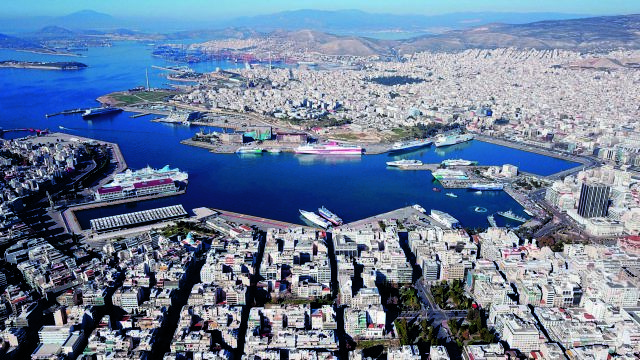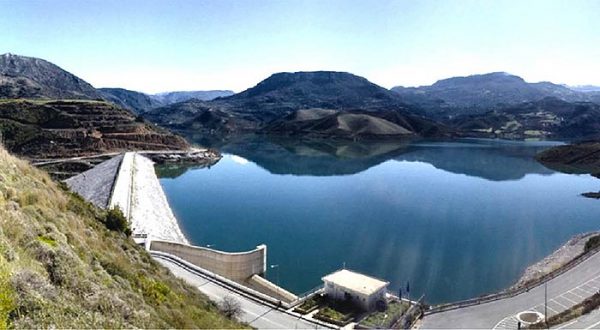
The improvement of Thessaloniki‘s connectivity with global shipping networks and the difficulty of Piraeus to maintain the dynamics it had demonstrated in previous years are recorded in the new edition of the sectoral study on the Greek port industry GREPORT, which is edited by professors Giorgos Vangelas, Thanos Pallis and Evi Kladaki. GREPORT 2022 examines the transport work, traffic and financial data of the country’s major ports.
According to a study, Greek ports need to improve their competitiveness in a rapidly changing environment. The disruption in global transport and supply chains, as well as the increase in the number of blank sailings by container shipping companies, have had knock-on effects in the container freight market and in ports.
In the Mediterranean, the reduction of container ship calls to ports from 2019 to date amounts to 2%. At the same time, the ports are called upon to serve larger ships. The percentage of approaches by ships with a capacity of more than 8,500 TEU increased in 2021 by 3.9% and in 2022 it is increased by 5.2%. This development translates into the management of a larger quantity of containers per approach, with this increase amounting to 5.7% within the three years 2019-2022, Mr. Thanos Pallis, professor at Piraeus University, reports to ot.gr.
In these circumstances, any improvement in the competitiveness of Greek ports is reflected in its connectivity to global networks. According to the data presented by GREPORT2022, in the period 2020-2021 in this sector the Greek port system showed a reversal of the dynamics recorded before 2020.
Port of Piraeus: Recovery at two speeds
The connectivity of Greek ports declined both in absolute terms and in comparison with neighboring ports, says Mr. George Vangelas, associate professor at the University of the Aegean. The distance to neighboring Italian ports has widened, returning to the levels it was a decade earlier. It is indicative that at the end of 2021, after a four-year break, Turkish ports again show greater connectivity than Greek ports.
The trend in Piraeus is of course decisive. From 2020 to the third quarter of 2022, the connectivity of the port of Piraeus to the global container transport network did not show the dynamics of the period it showed in previous years, remaining at the levels of 2019. At the same time, in the first three quarters of 2022 , the handling of containers appears reduced by 10.5% compared to the corresponding period of 2021, the study of Greek scientists points out.
Of course, the port of Piraeus continues to be directly connected to some of the largest port hubs in the global maritime transport network. In particular, the port in 2021 was connected directly (origin-destination) with Singapore with 25 routes per month, Port Klang (Malaysia) with four connections and with the European ports of Rotterdam and Antwerp with 16 and 13 monthly connections respectively. In the same period, the largest container ship in capacity that served the port of Piraeus in 2022 (January – July data) had a capacity of 23,992 TEU, when the corresponding size for 2021 was 21,413 TEU and in 2020 it was 21,400 TEU.
Although Piraeus is included in the largest container ports worldwide, in 2021, the port fell to 33rd place in the relative ranking, from 28th place in 2021. In the European area, it occupies 5th place in the relative ranking of container ports, which according to the figures of the first three quarters, despite the decrease in traffic, are expected to be maintained in 2022.
In the same period, the connectivity of the port of Thessaloniki appears to be particularly improved – although, as expected, it is at lower levels than Piraeus. The relevant index (Liner Shipping Connectivity Index) of the port increased in the third quarter of 2022 to higher levels compared to the beginning of the decade, while the last quarter of 2021 was at the highest historical level of the fifteen years for which relevant measurements are available, points out the industry study.
As in the case of Piraeus and in the port of Thessaloniki, the size of the largest container ship approaching the port increased significantly. In 2022 the largest ship had a capacity of 6,722 TEU compared to 5,730 TEU in 2021 and 5,300 TEU in 2020.
As GREPORT 2022 records, the necessary investments and the formation of conditions and strategies to further improve the capacity of the Greek port system remain necessary so that it can efficiently and effectively serve the transported cargoes. Together with the expansion of the range of services offered to transported loads before the transport of transported goods to their final destination, they are conditions for expanding the number of containers served by Greek ports and increasing the connectivity of the Greek economy with the rest of the world.
Latest News

Airbnb: New Measures Add €600 in Extra Costs for Property Owners
Property managers face an immediate administrative fine of 5,000 euros if access to the inspected property is denied or any of the specified requirements are not met.

Economist: Greece Included in the Best Performing Economies in 2024
Meanwhile, Northern European countries disappoint, with sluggish performances from the United Kingdom and Germany.

EasyJet Expands Its Routes from Athens
The airline’s two new routes will be to London Luton and Alicante and they will commence in summer 2025.

Capital Link Forum Highlights Greece’s Economic Resurgence; Honors BoG Gov Stournaras
Capital Link Hellenic Leadership Award recipient, Bank of Greece Gov. Yannis Stournaras, an ex-FinMin, was lauded for his pivotal role during Greece’s economic recovery

Tourist Spending in Greece Up by 14%, Visa Card Analysis Shows
Greece’s capital Athens emerged as the most popular destination, recording a 17% increase in transactions with Visa cards, surpassing even the cosmopolitan island of Mykonos.

Inflation in Greece Unchanged at 2.4% in Nov. 2024
The general consumer price index (CPI) posted a 0.4% decrease in November compared to the previous month

2024 Christmas Holidays: Extended Shop Hours Schedule
The 2024 Christmas Holidays extended shop hours schedule commences on Thursday, December 12 and runs until the end of the year.

ELSTAT: Seasonally Adjusted Unemployment Down in October
The number of employed individuals reached 4,284,694, an increase of 67,723 compared to October 2023 (+1.6%) and 22,002 compared to September 2024 (+0.5%).

Greek PM’s Chief Economic Adviser Resigns
In the post on his Facebook page, Patelis did not disclose the reasons that led him to step down.

“Masdar Invests in the people of Greece and in the vision of TERNA ENERGY”
Four messages from the CEO of Masdar, the Arab renewable energy giant, after its acquisition of 70% of TERNA ENERGY













![Fraport: Πάνω από 35 εκατ. επιβάτες στα αεροδρόμια το 11μηνο – Πτώση στη Μύκονο [πίνακας]](https://www.ot.gr/wp-content/uploads/2022/06/fraport-90x90.jpg)

























![Fraport: Πάνω από 35 εκατ. επιβάτες στα αεροδρόμια το 11μηνο – Πτώση στη Μύκονο [πίνακας]](https://www.ot.gr/wp-content/uploads/2022/06/fraport-600x375.jpg)


 Αριθμός Πιστοποίησης Μ.Η.Τ.232433
Αριθμός Πιστοποίησης Μ.Η.Τ.232433